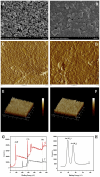Development of an electrochemical sensor modified with gold nanoparticles for detecting fumonisin B1 in packaged foods
- PMID: 39285870
- PMCID: PMC11403390
- DOI: 10.1039/d4ra04753b
Development of an electrochemical sensor modified with gold nanoparticles for detecting fumonisin B1 in packaged foods
Abstract
Fumonisin B1 (FB1) is naturally present in the environment and can easily contaminate packaged foods during processing, storage and transportation, thus posing a threat to human health. We have developed an enzyme-free FB1 detector for the detection of packaged foods, which provides rapid and sensitive detection of FB1 in food. Gold nanoparticles (AuNPs; 5-10 nm) were uniformly dispersed on screen-printed electrodes, which acted as an excellent catalytic oxidizer. The surface structure of the modified electrode was characterized using scanning electron microscope and X-ray photoelectron spectroscopy. Differential pulse voltammetry demonstrated a good linear electrochemical response towards FB1 at concentrations ranging from 1 ng L-1 to 1 mg L-1 with a detection limit of 0.08 ng L-1. We employed the AuNPs-SPE sensor to detect FB1-spiked packaged meat products achieving recovery rates ranging from 89.7% to 113.3%.
This journal is © The Royal Society of Chemistry.
Conflict of interest statement
The authors declare that they have no known competing financial interests or personal relationships that could have appeared to influence the work reported in this paper.
Figures







References
-
- Shephard G. S. Burger H.-M. Rheeder J. P. Alberts J. F. Gelderblom W. C. A. Food Control. 2019;97:77–80.
-
- Pleadin J. Kovačević D. Perši N. Food Control. 2015;57:377–384.
-
- Abd-Elghany S. M. Sallam K. I. Food Chem. 2015;179:253–256. - PubMed
LinkOut - more resources
Full Text Sources

